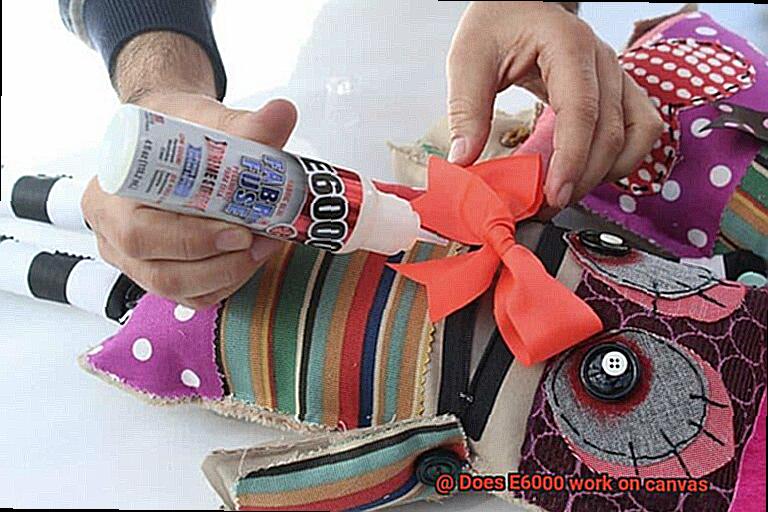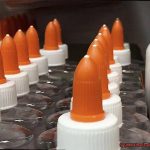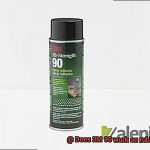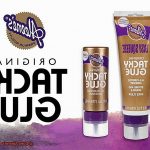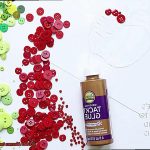If you’re anything like me, you know that finding the perfect adhesive can make or break your artistic endeavors. That’s why we’re diving headfirst into the captivating world of E6000 today – a magical adhesive that has artists and crafters buzzing with excitement.
But here’s the million-dollar question we’re tackling: does E6000 have what it takes to stick it to canvas? Get ready to be blown away as we explore the incredible versatility, rock-solid reliability, and sheer power of this adhesive in transforming ordinary canvases into magnificent masterpieces.
So, grab your paintbrushes and let’s embark on this thrilling journey together as we uncover the untapped potential of E6000 when it meets our beloved canvas medium.
Advantages of Using E6000 on Canvas
Contents
- 1 Advantages of Using E6000 on Canvas
- 2 Considerations Before Applying E6000 on Canvas
- 3 Surface Preparation for Bonding E6000 with Canvas
- 4 Drying Time for Bonding E6000 with Canvas
- 5 Application Techniques for Bonding E6000 with Canvas
- 6 Limitations of Using E6000 on Canvas
- 7 Alternatives to Using E6000 on Canvas
- 8 Conclusion
The creation of canvas artwork is a deeply satisfying process, but ensuring that all elements stay securely in place can be a challenge. Enter E6000 adhesive, a powerful glue renowned for its ability to enhance canvas projects. Artists and crafters alike turn to this high-performance adhesive for its numerous advantages. In this article, we will explore the benefits of using E6000 on canvas and how it can elevate your artwork to new heights.
Unbreakable Bonds:
E6000 is revered for its unmatched strength and durability, making it an ideal choice for canvas projects of all kinds. Whether you’re attaching embellishments, securing patches or appliques, or mending tears or holes, E6000 creates a permanent bond that stands the test of time. Bid farewell to worries about your artwork falling apart and embrace the confidence that comes with knowing your creation is built to last.
Versatility at Its Finest:
The versatility of E6000 on canvas is unparalleled. This adhesive seamlessly adheres to both porous and non-porous surfaces, ensuring compatibility with any type of canvas material. Its adaptability makes it an indispensable tool in the arsenal of artists and crafters working with a variety of mediums.
Flexibility Ensures Permanence:
Canvas artwork may experience some degree of movement or tension over time, but with E6000, flexibility is not an issue. Once cured, this adhesive allows the bond to remain strong even as the canvas stretches or flexes. The permanence it offers ensures that your artwork remains intact and unblemished, regardless of any environmental stressors.
Defying Mother Nature:
For those creating outdoor canvas artwork or pieces exposed to different weather conditions, E6000 is a game-changer. Once fully cured, this adhesive exhibits remarkable resistance to heat, cold, humidity, and water. No matter what Mother Nature throws at your creation, rest assured it will remain unscathed and visually stunning.
Aesthetic Excellence:
When working on canvas projects, aesthetics are paramount. E6000 dries clear and transparent, leaving no visible residue or marks behind. This allows your artwork to take center stage without any distractions or blemishes. The adhesive becomes virtually invisible, ensuring that the focus remains solely on your artistic expression.
Shelf Life That Lasts:
E6000 boasts a commendable shelf life, making it an ideal choice for artists and crafters who may not use adhesive frequently or need to store it for future projects. With this adhesive, you can have peace of mind knowing that it remains usable whenever inspiration strikes.
Considerations Before Applying E6000 on Canvas
Prepare to embark on a glue-filled journey, unlocking the secrets of using E6000 on canvas. We all desire our artwork to withstand the test of time, don’t we? To achieve that, let’s delve into the crucial considerations that will guarantee your adhesive adventure is a resounding success.
First and foremost, compatibility reigns supreme. Not all adhesives harmonize with every type of canvas. Think of it as a love story – you seek the perfect match. Before diving headfirst into your project, conduct a small test patch to ensure no adverse reactions or compatibility issues arise.
Next up, prepare the surface for bonding. Picture this: a pristine canvas, eagerly awaiting its union with E6000. Pure bliss. Utilize a lint-free cloth and mild soap solution to wipe away any dirt or debris. For an extra grip-tastic result, gently roughen the surface with sandpaper.
Now, let’s discuss the importance of ventilation. Ah, the sweet scent of success…and E6000. However, beware. The potent odor can overwhelm enclosed spaces. Open windows or grab a fan to ensure fresh air circulates, preventing any discomfort.
Application techniques are an art form in themselves. Thin, even layers are the secret ingredient here. Choose a brush or applicator that suits your artistic prowess and refrain from going overboard with the glue. Messiness is not our ally in this case.
Patience, my friend, is key. Allow those bonds to cure properly by providing ample drying time. Temperature, humidity, and adhesive thickness all play their part in this process. Consult the manufacturer’s instructions for specific guidelines and resist the urge to rush it. Good things come to those who wait.
Finally, once your masterpiece is complete, handle it delicately during curing. E6000 reaches its peak strength after a day or two, so avoid excessive stress or moisture. Treat it as a fragile blossom, patiently awaiting its full adhesive potential.
By keeping these considerations in mind, you’ll confidently forge unbreakable bonds between E6000 and canvas. So, let the adhesive flow, my friends, and let your artwork radiate for years to come.
Surface Preparation for Bonding E6000 with Canvas
Achieving a strong and durable bond between E6000 adhesive and canvas requires proper surface preparation. Just like building a solid relationship, the foundation is key. So, before diving into the gluing process, take the time to prepare your canvas surface for optimal results.
- Cleanse the Canvas: Begin by ensuring your canvas is as clean as a whistle. Use a soft cloth or brush to gently remove any dirt, dust, or debris that may be clinging to the surface. This step is crucial to prevent any interference with the adhesive bond.
- Wipe with Solvent: Give your canvas a little spa treatment by wiping it down with a mild solvent such as isopropyl alcohol or acetone. This will eliminate any oils or residues that could hinder the adhesive’s effectiveness. Think of it as giving your canvas a fresh start, ready for its adhesive companion.
- Thorough Drying: Moisture can be the ultimate buzzkill for adhesives, so make sure your canvas is bone dry before moving forward. Allow sufficient time for the canvas to air dry completely or use a low setting on your hairdryer to speed up the process. Patience is key.
- Light Sanding: If your canvas has been treated with coatings or finishes in the past, lightly sanding the surface is recommended. This creates a rougher texture, providing the adhesive with something to grip onto. Use fine-grit sandpaper and gently sand in circular motions until you achieve that perfect texture.
- Dust Removal: After sanding, eliminate any leftover sanding dust from the canvas. Give it another gentle wipe with a clean cloth or blow off the dust with compressed air. A clean canvas is essential for optimal bonding.
- Apply E6000 Adhesive: Now it’s time to bring out the star player – E6000 adhesive. Apply a thin layer of adhesive onto both surfaces that you’re bonding together. Use a brush or applicator to evenly spread the adhesive over the canvas. Then, press the surfaces firmly together, ensuring good contact.
- Patience is Key: Don’t rush off just yet. Allow sufficient curing time as specified by the manufacturer before handling or applying any additional stress on the bond. Treat your masterpiece delicately like a fragile blossom awaiting its full potential.
Drying Time for Bonding E6000 with Canvas
You’ve probably wondered about the best adhesive to use for bonding materials. Look no further than E6000, a versatile and reliable adhesive that can bring your creative visions to life. In this article, we will explore the drying time for bonding E6000 with canvas, providing you with all the information you need to ensure a strong and lasting bond.
Factors Affecting Drying Time:
Before we delve into specifics, it’s important to understand that drying time can vary depending on several key factors. These factors include the thickness of the adhesive layer, temperature, humidity, and the type of materials being bonded. So, let’s break it down:
- Thickness of the adhesive layer: Applying a thin, even layer of E6000 adhesive is crucial for proper adhesion and minimizing drying time.
- Temperature and humidity: Higher temperatures and lower humidity levels can speed up the drying process, while cooler temperatures and higher humidity levels may prolong it. Consider these factors when planning your project.
Recommended Drying Time:
Now that we have a general understanding of the factors at play, let’s talk specifics. In most cases, E6000 takes approximately 24 to 72 hours to fully cure and reach its maximum bond strength. However, during this curing period, it may still be slightly tacky or sticky to the touch.
Tips for Optimal Results:

To ensure optimal results with your E6000 adhesive:
- Apply a thin, even layer of adhesive to both surfaces being bonded.
- Allow the adhesive to dry undisturbed for at least 24 hours before handling or manipulating the bonded canvas.
- If you need to speed up the drying process, you can use a hairdryer on a low heat setting or place a fan near the bonded area to increase air circulation. However, be cautious not to apply excessive heat, as it may damage the canvas or affect the adhesive’s performance.
- Always test the adhesive on a small inconspicuous area of the canvas before applying it more extensively to ensure compatibility and determine any potential issues with adhesion or drying time.
- Follow the manufacturer’s instructions and safety guidelines when using E6000 or any other adhesive product.
Application Techniques for Bonding E6000 with Canvas
Look no further than E6000. This versatile and reliable bonding agent is the go-to choice for many artists who crave a robust and enduring connection between their materials.
To achieve the best results when bonding E6000 with canvas, there are a few application techniques that you should keep in mind. Let’s explore them one by one:
- Surface Preparation: Before applying E6000 on canvas, it is crucial to ensure that the surface is squeaky clean. Take a damp cloth and wipe away any dirt, dust, or debris. This simple step sets the foundation for a strong bond between the glue and the canvas.
- Test on a Small Area: Don’t dive headfirst into applying E6000 on the entire canvas. Instead, test it on a small, inconspicuous area first. This way, you can determine if the glue meshes well with your specific canvas material without causing damage or discoloration.
- Apply a Thin and Even Layer: When it comes time to apply the glue, remember: less is more. Use a brush or applicator to apply a thin and even layer of E6000 on the canvas. Avoid slathering on too much glue, as it can seep through the fibers and create an unsightly mess.
- Allow for Proper Drying Time: E6000 needs ample time to dry for optimal bonding. Be patient and let the adhesive dry for at least 24 to 72 hours, depending on thickness and humidity levels. Fight the urge to touch or move the canvas during this period to ensure a strong and secure bond.
- Gentle Pressure: After applying the glue, gently press the surfaces together to maximize contact and adhesion. To evenly distribute pressure across the glued area, use your hands or a roller tool. Be cautious not to exert excessive force that could distort the canvas.
- Consider Using Clamps or Weights: For larger projects or areas that require extra support, clamps or weights can be your secret weapon. They hold the glued sections together while they dry, preventing any shifting or movement that could compromise the bond.
- Temperature Considerations: E6000 performs at its best when applied and cured at room temperature. Avoid extreme heat or cold environments, as they can impact the adhesive properties. Additionally, ensure your workspace is well-ventilated to facilitate proper drying and minimize fume inhalation.
- Post-Bonding Care: Once E6000 has dried and bonded with the canvas, handle your artwork with tender care. Steer clear of exposing it to excessive heat, moisture, or direct sunlight, as these factors can weaken the bond over time. Regularly inspect the glued areas for signs of deterioration and reapply adhesive if needed.
Limitations of Using E6000 on Canvas
Look no further than E6000. Renowned for its robust bond and versatility, E6000 has gained popularity among artists. However, before you embark on applying it to your canvas, it’s crucial to understand its limitations and explore alternative options that may better suit your needs. In this blog post, we will delve into the limitations of using E6000 on canvas and suggest alternatives that could be a superior fit for your projects.
Not Specifically Designed for Fabric and Porous Surfaces:
- E6000 is primarily formulated for bonding hard materials like metal, wood, and plastics.
- It may not adhere as well to canvas as adhesives specifically designed for fabric or porous surfaces.
- This can compromise durability and longevity.
Alternative: Consider fabric glues or adhesives designed explicitly for use on canvas. These products create a strong bond with fabric surfaces, ensuring a long-lasting hold.
Messy Application:
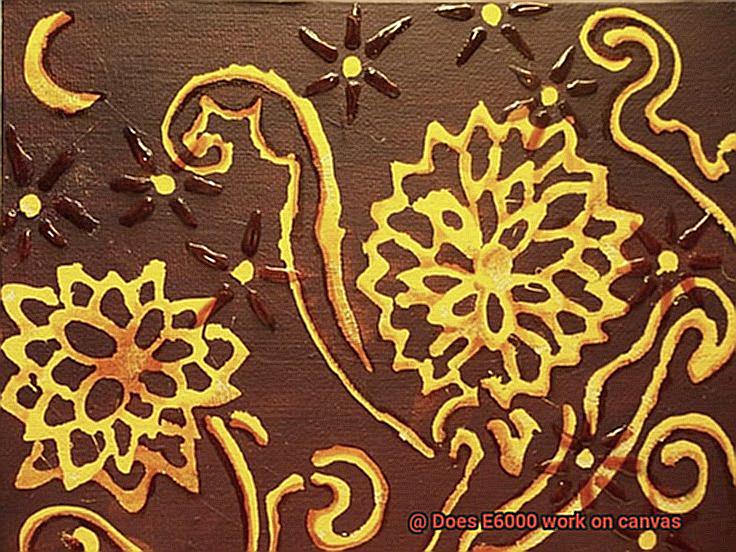
- E6000 is a thick and viscous adhesive, making it challenging to work with on canvas, especially for intricate or detailed projects.
- It requires careful application to avoid smearing or spreading onto unwanted areas of the canvas.
Alternative: Opt for glues with a thinner consistency, facilitating precise application without creating a mess. These glues are often available in squeeze bottles or applicator pens, enabling more controlled application.
Toxic Chemicals and Strong Odor:
- E6000 contains harmful chemicals like toluene, which can be toxic if inhaled or absorbed through the skin.
- The adhesive also emits a strong odor that can be unpleasant to work with.
- Alternative: Seek adhesives labeled as non-toxic with low VOC (volatile organic compounds) content. These alternatives are safer to use, particularly in enclosed spaces or without proper ventilation.
Lack of Flexibility:
- E6000 is a rigid adhesive that may not provide the flexibility and stretch required for canvas artworks that need to be stretched or wrapped around frames.
- This can lead to issues like cracking or peeling over time.
- Alternative: Consider using flexible adhesives specifically designed for canvas. These adhesives accommodate the natural movement of the canvas, ensuring your artwork remains intact and free from damage.
Unsuitable for Extreme Conditions:
- E6000 may not withstand extreme temperatures or high levels of moisture, compromising the integrity of your artwork.
- Alternative: Explore adhesives formulated to endure extreme conditions, such as heat-resistant or waterproof glues. These alternatives guarantee your artwork remains intact even in challenging environments.
Alternatives to Using E6000 on Canvas
There are plenty of options that can give you a strong bond without the downsides. Let’s explore some alternatives and considerations for selecting the perfect one for your project.
- Fabric Glue: If you’re working with fabric, fabric glue is a fantastic option. It’s specially designed for bonding fabric materials and offers a strong hold. With washable and non-washable options available, you can choose the one that suits your project best. Applying it is a breeze too – just grab a brush or nozzle and get to work.
- Mod Podge: Ah, good ol’ Mod Podge. This versatile adhesive and sealant can be used on multiple surfaces, including canvas. It’s easy to use and dries clear, making it ideal for collage work or adhering paper elements to your canvas masterpiece. With different formulations like matte, glossy, and satin, you can achieve various finishes too.
- Acrylic Gel Medium: Are you into mixed media art? Then acrylic gel medium might be the alternative for you. It acts as both an adhesive and a sealant, providing a strong bond while also protecting the surface. Plus, it comes in different viscosities, allowing for different textures and thicknesses in your artwork.
- Heat Transfer Vinyl: Looking to attach designs or graphics onto your canvas? Heat transfer vinyl could be just what you need. This material requires heat and pressure to adhere to fabric surfaces, including canvas. It’s commonly used in textile decoration and can create vibrant and long-lasting designs on your artwork.
- Sewing or Stitching: For those who prefer a more traditional approach, sewing or stitching can be an effective way to attach fabric to canvas. This method gives you flexibility and allows for repositioning if needed. It’s especially handy when working with thicker or heavier fabrics that may not adhere well with adhesives.
- Double-sided Tape: Need a quick and easy alternative? Look no further than double-sided tape. It’s perfect for lightweight fabrics and provides a temporary bond. Plus, it’s easily removable and repositionable, making it great for experimenting with different placements.
When choosing an alternative to E6000 on canvas, always consider the specific project requirements and materials involved. It’s a good idea to test the chosen alternative on a small, inconspicuous area of the canvas before committing to the entire surface. This way, you can ensure compatibility and achieve the desired results.
b2Dd2_BjEWY” >
Conclusion
The answer to the question “Does E6000 work on canvas?” is a resounding yes. This incredible adhesive is not only capable of bonding various materials together, but it also works wonders on canvas.
Its strong and durable bond ensures that your creations will withstand the test of time.

